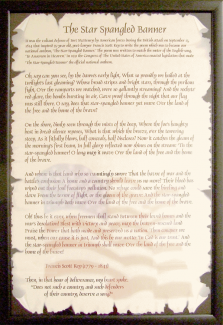The Star-Spangled Banner
Guarding the entrance to Baltimore harbor via the Patapsco River during the War of 1812, Fort McHenry faced almost certain attack by British forces. Major George Armistead, the stronghold´s commander, was ready to defend the fort, but he wanted a flag that would identify his position, one whose size would be visible to the enemy from a distance. The flag that was made for the fort was 30 feet by 42 feet. Anxiously awaiting news of the battle´s outcome was a Washington, D.C., lawyer named Francis Scott Key. Key had visited the enemy´s fleet to secure the release of a Maryland doctor who had been abducted by the British after they left Washington. The lawyer had been successful in his mission, but he could not escort the doctor home until the attack ended. So he waited on a flag-of-truce sloop anchored eight miles downstream from Fort McHenry.
During the night, there had been only occasional sounds of the fort´s guns returning fire. At dawn, the British bombardment tapered off. Had the fort been captured? Placing a telescope to his eye. Key trained it on the fort´s flagpole. There he saw the large garrison flag catch the morning breeze. It had been raised as a gesture of defiance, replacing the wet storm flag that had flown through the night. Thrilled by the sight of the flag and the knowledge that the fort had not fallen, Key took a letter from his pocket and began to write some verses on the back of it. Later, after the British fleet had withdrawn, Key checked into a Baltimore hotel and completed his poem on the defense of Fort McHenry. He then sent it to a printer for duplication on handbills, and within a few days, the poem was put to the music of an old English song. Both the new song and the flag became known as 'The Star-Spangled Banner' and became a rallying cry for the American Patriots during the rest of the war.

